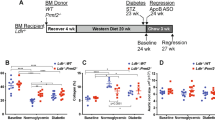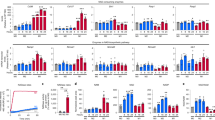Abstract
Both the risk and the rate of development of atherosclerosis are increased in diabetics, but the mechanisms involved are unknown. Here we report a glucose-mediated increase in CD36 mRNA translation efficiency that results in increased expression of the macrophage scavenger receptor CD36. Expression of CD36 was increased in endarterectomy lesions from patients with a history of hyperglycemia. Macrophages that were differentiated from human peripheral blood monocytes in the presence of high glucose concentrations showed increased expression of cell-surface CD36 secondary to an increase in translational efficiency of CD36 mRNA. We obtained similar data from primary cells isolated from human vascular lesions, and we found that glucose sensitivity is a function of ribosomal reinitiation following translation of an upstream open reading frame (uORF). Increased translation of macrophage CD36 transcript under high glucose conditions provides a mechanism for accelerated atherosclerosis in diabetics.
This is a preview of subscription content, access via your institution
Access options
Subscribe to this journal
Receive 12 print issues and online access
$209.00 per year
only $17.42 per issue
Buy this article
- Purchase on SpringerLink
- Instant access to full article PDF
Prices may be subject to local taxes which are calculated during checkout






Similar content being viewed by others
References
Semenkovich, C.F. & Heinecke, J.W. Perspectives in diabetes: the mystery of diabetes and atherosclerosis. Diabetes 46, 327–334 (1997).
Schmidt, A. et al. RAGE: A novel cellular receptor for advanced glycation end products. Diabetes 45, 77–80 (1996).
Vlassara, H. Recent progress in advanced glycation end products and diabetic complications. Diabetes 46, 19–24 (1997).
Berliner, J.A. Atherosclerosis: Basic mechanisms. Circulation 91, 2488–2496 (1995).
Boring, L., Gosling, J., Cleary, M. & Charo, I.F. Decreased lesion formation in CCR2−/− mice reveals a role for chemokines in the initiation of atherosclerosis. Nature 394, 894–897 (1998).
Witzium, J.L. & Steinberg, D. Role of oxidized low density lipoprotein in atherogenesis. J. Clin. Invest. 88, 1785–1792 (1991).
Nagy, L., Tontonoz, P., Alvarez, J., Chen, H. & Evans, R. Oxidized LDL regulates macrophage gene expression through ligand activation of PPARγ. Cell 93, 229–240 (1998).
Tontonoz, P., Nagy, L., Alvarez, J., Thomazy, V. & Evans, R. PPARγ promotes monocyte/macrophage differentiation and uptake of oxidized LDL. Cell 93, 241–252 (1998).
Endemann, G. et al. CD36 is a receptor for oxidized low density lipoprotein. J. Biol. Chem. 268, 11811–11816 (1993).
Huh, H., Pearce, S.F., Yesner, L.M., Schindler, J.L. & Silverstein, R.L. Regulated expression of CD36 during monocyte to macrophage differentiation: potential role of CD36 in foam cell formation. Blood 87, 2020–2028 (1996).
Nozaki, S. Reduced uptake of oxidized low density lipoproteins in monocyte-derived macrophages from CD36-deficient subjects. J. Clin. Invest. 96, 1859–1865 (1995).
Podrez, E. et al. Macrophage scavenger receptor CD36 is the major recptor for LDL modified by monocyte-generated reactive nitrogen species. J. Clin. Invest. 105, 1095–1108 (2000).
Febbraio, M. et al. Targeted disruption of the class B scavenger receptor, CD36, protects against atherosclerotic lesion development in mice. J. Clin. Invest. 105, 1049–1056 (2000).
Spiegelman, A. PPARγ in monocytes: less pain, any gain? Cell 93, 153–155 (1998).
Greenwalt, D.E., Scheck, S.H. & Rhinehart-Jones, T. Heart CD36 expression is increased in murine models of diabetes and in mice fed a high fat diet. J. Clin. Invest. 96, 1382–1388 (1995).
McCaffrey, T. et al. Decreased Type II/Type I TGF-β1 receptor ratio in cells derived from human atherosclerotic lesions: Conversion from an antiproliferative to profibrotic response to TGF-β1. J. Clin. Invest. 96, 2667–2675 (1995).
Kolm-Litty, V., Sauer, U., Nerlich, A., Lehmann, R. & Scheicher, E.D. High glucose-induced transforming growth factor b-1 production is mediated by the hexosamine pathway in porcine glomerular mesangial cells. J. Clin. Invest. 101, 160–169 (1998).
Ashe, M., DeLong, S. & Sachs, A. Glucose depletion rapidly inhibits translation initiation in yeast. Mol. Biol. Cell 11, 833–848 (2000).
Skelly, R.H., Schuppin, G.T., Ishihara, H., Oka, Y. & Rhodes, C.J. Glucose-regulated translational control of proinsulin biosynthesis with that of the proinsulin endopeptidases PC2 and PC3 in the insulin-producing MIN6 cell line. Diabetes 45, 37–43 (1996).
Iynedjian, P.B. et al. Differential expression and regulation of the glucokinase gene in liver and islets of Langerhans. Proc. Natl. Acad. Sci. USA 86, 7838–7842 (1989).
Semenkovich, C.F., Coleman, T. & Fiedorek, F.T.J. Human fatty acid synthase mRNA: tissue distribution, genetic mapping, and kinetics of decay after glucose deprivation. J. Lipid Res. 36, 1507–1520 (1995).
Guest, P.C., Bailyes, E.M., Rutherford, N.G. & Hutton, J.C. Insulin secretory granule biogenesis. Co-ordinate regulation of the biosynthesis of the majority of constituent proteins. Biochem J. 274, 73–78 (1991).
Hinnebusch, A.G. in Translational Control (eds. Hershey, J.W.B., Mathews, M.B. & Sonenberg, N.) 199–244 (Cold Spring Harbor Laboratory Press, Cold Spring Harbor, 1996).
Gilligan, M. et al. Glucose stimulates the activity of the guanine nucleotide-exchange factor eIF-2B in isolated rat islets of Langerhans. J. Biol. Chem. 271, 2121–2125 (1996).
Morris, D. & Geballe, A. Upstream open reading frames as regulators of mRNA translation. Mol. Cell. Biol. 20, 8635–8642 (2000).
Abastado, J., Miller, P., Jackson, B. & Hinnebusch, A. Suppression of ribosomal reinitiation at upstream open reading frames in amino acid-starved cells forms the basis for GCN4 translational control. Mol. Cell. Biol. 11, 486–496 (1991).
Laakso, M. & Muusisto, J. Epidemiological evidence for the association of hyperglycemia and atherosclerotic vascular disease in non-insulin-dependent diabetes mellitus. Ann. Med. 28, 415–418 (1996).
Schmidt, A., Yan, S., Wautier, J. & Stern, D. Activation of receptor for advanced glycation end products: a mechanism for chronic vascular dysfunction in diabetic vasculopathy and atherosclerosis. Circ. Res. 84, 489–497 (1999).
Ohgami, N. et al. CD36, a member of the class B scavenger receptor family, as a receptor for advanced glycation endproducts. J. Biol. Chem. 276, 3195–3202 (2001).
Hunt, J. V., Bottoms, M. A., Clare, K., Skamarauskas, I. T. & Mitchinson, M. Glucose oxidation and low-density lipoprotein-induced macrophage ceroid accumulation: possible implications for diabetic atherosclerosis. Biochem. J. 300, 243–249 (1994).
Aitman, T. et al. Identification of CD36 (FAT) as an insulin-resistance gene causing defective fatty acid and glucose metabolism in hypertensive rats. Nature Genet 21, 76–83 (1999).
Febbraio, M. et al. A null mutation in murine CD36 reveals an important role in fatty acid and lipoprotein metabolism. J. Biol. Chem. 274, 19055–19062 (1999).
Barak, Y. et al. PPARγ is required for placental, cardiac and adipose tissue development. Mol. Cell 4, 585–595 (1999).
Barroso, I. et al. Dominant negative mutations in human PPARγ associated with sever insulin resistance, diabetes mellitus and hypertension. Nature 402, 880–883 (1999).
El-Jack, A., Hamm, J., Pilch, P. & Farmer, S. Reconstitution of insulin-sensitive glucose transport in fibroblasts requires expression of both PPARγ and C/EBPalpha. J. Biol. Chem. 274, 7946–7951 (1999).
Le, S.-Y. & Maizel, J.V.J. A common RNA structural motif involved in the internal initiation of translation of cellular mRNAs. Nucleic Acids Res. 25, 362–369 (1997).
Koromilas, A. E., Lasaris-Karatzas, A. & Sonenberg, N. mRNAs containing extensive secondary structure in their 5′ non-coding region translate efficiently in cells overexpressing initiation factor eIF-4E. EMBO J. 4153–4158 (1992).
Kozak, M. Regulation of translation in eukaryotic systems. Annu. Rev. Cell Biol. 8, 197–225 (1996).
Davuluri, R., Suzuki, Y., Sugano, S. & Zhang, M.Q. CART Classification of HNuman 5′ UTR Sequences. Genome Research 10, 1807–1816 (2000).
Beaumont, C. et al. Mutation in the iron responsive element of the L ferritin mRNA in a family with dominant hyperferritinaemia and cataract. Nature Genet. 11, 444–446 (1995).
Mach, M., White, M.W., Neubauer, M., Degen, J.L. & Morris, D.R. Isolation of a cDNA clone encoding S-adenosylmethionine decarboxylase: expression of the gene in mitogen-activated lymphocytes. J. Biol. Chem. 261, 11697–11703 (1986).
Ho, S.N., Hunt, H.D., Horton, R.M., Pullen, J.K. & Pease, L.R. Site-directed mutagenesis by overlap extension using the polymerase chain reaction. Gene 77, 51–59 (1989).
Zuker, M., Mathews, D. & Turner, D. in RNA Biochemistry and Biotechnology (ed. Clark, J.B.) 11–43 (Kluwer Academic, Dordrecht, the Netherlands, 1999).
Mathews, D., Sabina, J., Zuker, M. & Turner, D. Expanded sequence dependence of thermodynamic parameters improves prediction of RNA secondary structure. J. Mol. Biol. 288, 911–940 (1999).
Acknowledgements
We thank J. Han for the gift of labeled Ox-LDL; F. Pearce for advice on the Ox-LDL studies; A. Cerutti for help with some of the flow cytometry; and M.J.R. Echevarria, D. Falcone and R. Nachman for their critical review of the manuscript. This research was supported by grants from the NIH (DK48698) and American Heart Association (to A.S.A.) and from Universita degli Studi di Parma, Parma, Italy (to A.R.).
Author information
Authors and Affiliations
Corresponding author
Rights and permissions
About this article
Cite this article
Griffin, E., Re, A., Hamel, N. et al. A link between diabetes and atherosclerosis: Glucose regulates expression of CD36 at the level of translation. Nat Med 7, 840–846 (2001). https://doi.org/10.1038/89969
Received:
Accepted:
Issue Date:
DOI: https://doi.org/10.1038/89969
This article is cited by
-
Inflammatory gene silencing in activated monocytes by a cholesterol tagged-miRNA/siRNA: a novel approach to ameliorate diabetes induced inflammation
Cell and Tissue Research (2022)
-
Chronic angiotensin receptor activation promotes hepatic triacylglycerol accumulation during an acute glucose challenge in obese-insulin-resistant OLETF rats
Endocrine (2022)
-
Vimentin deficiency in macrophages induces increased oxidative stress and vascular inflammation but attenuates atherosclerosis in mice
Scientific Reports (2018)
-
Psammomys obesus: a Natural Diet-Controlled Model for Diabetes and Cardiovascular Diseases
Current Atherosclerosis Reports (2018)
-
CD36 overexpression: a possible etiopathogenic mechanism of atherosclerosis in patients with prediabetes and diabetes
Diabetology & Metabolic Syndrome (2017)



